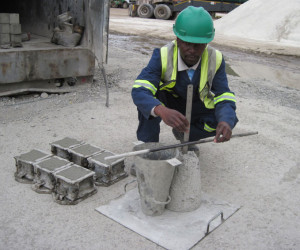Concrete slump is a definition of the consistency, often called workability, of concrete.
Slump Test
The slump test is defined by ASTM C143 and AASHTO T119 in the United States, and EN 12350-2 in Europe. There is no significant other testing method for concrete workability in industry use today.
A standard size cone (Base diameter 8 inches, top diameter 4 inches, and height 12 inches) is filled with concrete and then the cone is removed. The depth with which the concrete “slumps” measured downwards from the top of the cone, is called the slump.
Interpretation
Workability is an important consideration for concrete. A low water-cement ratio (i.e. low water content) is the most important factor in achieving concrete strength, but this comes at the sacrifice of workability.
I’ve seen many concrete pours where the mix was too stiff to consolidate properly within the forms. If you remove the forms and there are problems with the finished product, there is usually very little that can be done about it except removing the concrete and re-pouring it.
Let me give you some numbers. I’ve found that a slump of 0 – 50 mm is (2 inches) is pretty unworkable and the site inspector should make sure the the concrete is well consolidated. 50 – 200 mm (2 – 8 inches) is a good range where consolidation should be achievable. And more than 200 mm is when the mix is very wet.
Usually there is a specification for concrete slump from the mix design. When the slump comes in greater, the strength is probably lower, so the inspector should allow no more than a couple of inches (50 mm) than the design slump.

Speak Your Mind